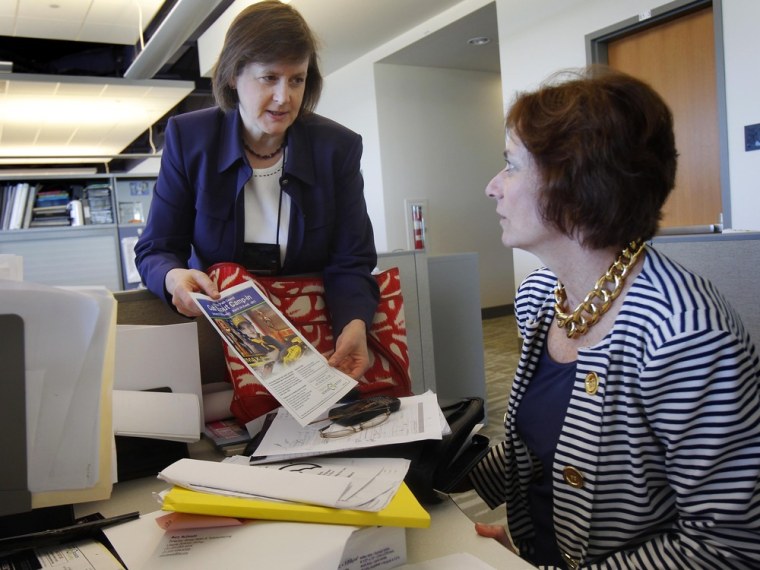Elizabeth Romanaux puts a brave face on working as an intern at the age of 55.
A media relations manager until she joined the millions of unemployed Americans two years ago, Romanaux spent the spring building contact lists and fetching lunches as she tried to keep alive her chances of resuming full employment.
"You have to suck it up sometimes and do what a 17-year-old would happily do and be happy about it," she said of her recent stint with a public relations firm in New Jersey.
Once the domain of high school and college students, internships are more common among older Americans who are struggling to find jobs and keep their skills up to date in the worst U.S. labor market in decades.
"A lot of adults who are either returning to the workforce or have been laid off in the recession are looking for places and ways to build a resume and fill a gap between jobs," said Margo Rose, founder of HireFriday, an online job search advice website.
"The last thing you want to do is look the interviewer in the eye with a blank stare when they ask you, 'What have you been doing for the last year?"'
Data is scant on the number of older interns but labor economists, internship recruiters and graduate school career officers agree the number has been on the rise.
"There has definitely been almost an explosion of this kind of thing," said Liz Ryan, of LizRyan.com, a career advice website. She says she had never been approached by mid-career clients seeking help securing an internship before 2008.
"In 2008, I had about 20 of them," she said.
That increased to 36 annually in 2009 and 2010.
Phil Gardner, research director for the Collegiate Employment Research Institute, which analyzes initial employment at Michigan State University, said the number of graduates taking internships "ballooned last year" before easing off as the U.S. labor market improved in early 2011.
Historically, college internships did not take off until the 1970s, when baby boomers flooded universities. From 1970 to 1983, the number of colleges and universities offering internship programs increased from 200 to 1,000.
The rise of older interns
The rising number of older interns now is symptomatic of the broader crisis in the U.S. labor market in which millions of Americans cannot get the kind of work they want.
While the U.S. unemployment rate ticked up to 9.1 percent in May, almost 16 percent of Americans were underemployed in the same month -- either out of work but looking, working part-time involuntarily or discouraged from searching for a job.
U.S. Labor Department data on Thursday showed initial claims for unemployment benefits dipped by just 1,000 to a seasonally adjusted 428,000 in the week ending June 25. That is far from the drop below 400,000 claims that would signal an improvement in the labor market.
Industry specialists disagree on what the increase in older interns mean for them and the labor market.
Ryan says internships can be the ticket for older interns to beat out more recent graduates for scarce entry-level jobs.
Six in 10 internships lead to jobs, according to the National Association of Colleges and Employers, an employment research group also known as NACE.
But for critics such as Ross Perlin, author of "Intern Nation," which examines the role of internships in the U.S. economy, unpaid labor harms everyone in the labor market.
Perlin estimates that American organizations save $2 billion annually by not paying interns minimum wage. He estimates between 1 million and 2 million college students intern in the United States each year.
According to NACE, 48 percent of internships are unpaid.
Seven percent of employers surveyed by CareerBuilder.com in 2009 reported receiving internship applications from workers over the age of 50. A quarter of employers also reported receiving applications for entry-level positions from the same age group.
Ryan says Will Smith's 2006 movie "The Pursuit of Happyness" may have contributed to the uptick in post-college- age interns.
In the movie, Smith's character loses everything in a get-rich-quick scheme selling bone density scanners. But in a Hollywood twist, he lands a stock brokerage internship, which, after six grueling months, turns into a job.
Trouble for teens
In the real world, some worry that older workers taking internships may further displace young workers from an already tight youth labor market.
"It pushes its way down the scale," said Ross Eisenbrey, vice president of the Economic Policy Institute, a Washington-based think tank.
The U.S. unemployment rate in May was more than 24 percent for 16- to 19-year-olds and it approached 15 percent for 20- to 24-year-olds. These are the two age groups most likely to intern.
Romanaux understands the cold business logic of using older workers as interns.
"If I could get someone like me for free, I would be apologetic about it, but I would do it."
Romanaux -- who is doing freelance consulting for the same museum that laid her off -- is grateful for her internship, which ended in May.
She says she learned about social media without having to pay the cost of tuition at a graduate school.
But she says there is nothing easy about starting over at 55.
"It was very stressful," she said, recalling early errors she made during her internship. "Even though they weren't paying me, I felt badly I couldn't do it well."
